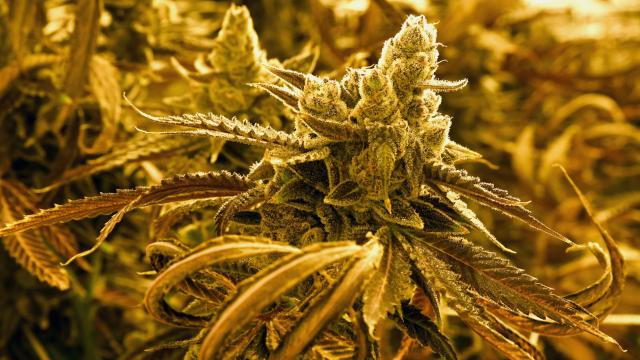As more U.S. states legalise weed, commercial production of it is increasing. These growing operations may not just be getting customers high — they may be getting the planet’s temperature higher, too.
A new study published in Nature Sustainability on Monday aims to quantify the climate impact of indoor cannabis cultivation across the country. The authors, who are researchers at Colorado State University, wanted to track how greenhouse gas-intensive these operations would be if they were set up anywhere in the country.
“Policymakers and consumers aren’t paying much attention to environmental impacts of the cannabis industry,” Jason Quinn, an associate professor of the mechanical engineering Department at Colorado State University and lead author of the study, wrote in an email. “There is little to no regulation on emissions for growing cannabis indoors. Consumers aren’t considering the environmental effect either. This industry is developing and expanding very quickly without consideration for the environment.”
Many cannabis growers prefer indoor cultivation to outdoor because it offers greater control over the plants’ habitats and more security. But these indoor operations come at a cost to the climate, since they require heating, ventilation, and air conditioning to maintain ideal temperature and humidity levels and high-intensity grow lights which stay on around the clock. They also often pump in a regular supply of carbon dioxide to speed up plant growth and increase profits.
[referenced id=”1677832″ url=”https://gizmodo.com.au/2021/03/whats-the-most-climate-safe-place-in-the-world/” thumb=”https://gizmodo.com.au/wp-content/uploads/2021/03/08/ftig2nfsgppvrgosado0-300×169.png” title=”What’s the Most Climate-Safe Place in the World?” excerpt=”It is easy to be pessimistic about the future. It is also easy to scientifically verify that pessimism through persuasive papers and charts. It is easier still to lose yourself in bleak visions of fires and floods, food and water shortages, widespread human suffering, violent apocalyptic cults, bad wi-fi, and…”]
To figure out just how carbon intensive growing weed is, the team of researchers developed a model to track the energy and materials used for the kind of indoor warehouse-style growing operation that 41% of American growers use. The model was designed to mimic an actual typical warehouse, complete with HVAC, grow lights, pesticides and fungicides, water applied through drip irrigation “at an average rate of 3.8 litres per plant per day,” and more.
Since temperatures and humidity across the U.S. vary widely, the authors’ model calculated the energy needed to maintain these indoor climate conditions by using a year’s worth of hourly weather data from over 1,000 locations countrywide. By using electrical grid emissions data from around the nation, the model then showed the greenhouse gas emissions that all that required energy would produce. In addition, the model accounted for the “upstream” emissions from producing and transporting water, fertilisers, fungicides, and bottles of carbon dioxide to grow houses, and also tracked the “downstream” greenhouse gas pollution from all the waste these operations send to landfills.
All told, the authors found that the cumulative greenhouse gas emissions created by one of these indoor cultivation warehouses was between 2,283 kilograms and 5,184 kilograms of carbon-equivalent per every 1 kilogram of dried flower. Put another way, the eighth of weed you buy (legally, of course) comes with up to a 19-kilogram carbon footprint.
The authors say it doesn’t have to ruin your buzz, though. We don’t need to give up growing weed. We just need to start shifting the industry toward more outdoor growing operations.
“If indoor cannabis cultivation were to be fully converted to outdoor production, these preliminary estimates show that the state of Colorado, for example, would see a reduction of more than 1.3% in the state’s annual [greenhouse gas] emissions,” the study says. That means Colorado alone would see a reduction of 2.3 million tons of carbon equivalent every year, which the study notes is roughly on par with emission from the state’s entire coal mining sector.
The study’s results suggest that 80% of the greenhouse gas emissions created by cannabis growing are caused by “caused by practices directly linked to indoor cultivation methods, specifically indoor environmental control, high-intensity grow lights and the supply of carbon dioxide for increased plant growth.” Yes, growing outdoors still requires materials and equipment to be shipped and still results in waste being sent to landfills — problems we should continue to work on. But it’s way less energy intensive, the authors found.
Of course, outdoor growing may not be possible in every part of the country. So within states, the authors also identified locations where indoor growing is comparatively less energy intensive. In Colorado, for instance, “the practice of growing cannabis in Leadville leads to 19% more GHG emissions than in Pueblo,” because the former tends to be colder. In climates where outdoor growing could work, policymakers should take steps to usher in the transition. That includes changing regulations and zoning codes to allow for more of these outdoor operations.
But all of this is just a first step, the authors say. There needs to be much more research into how to make this burgeoning industry more sustainable.
